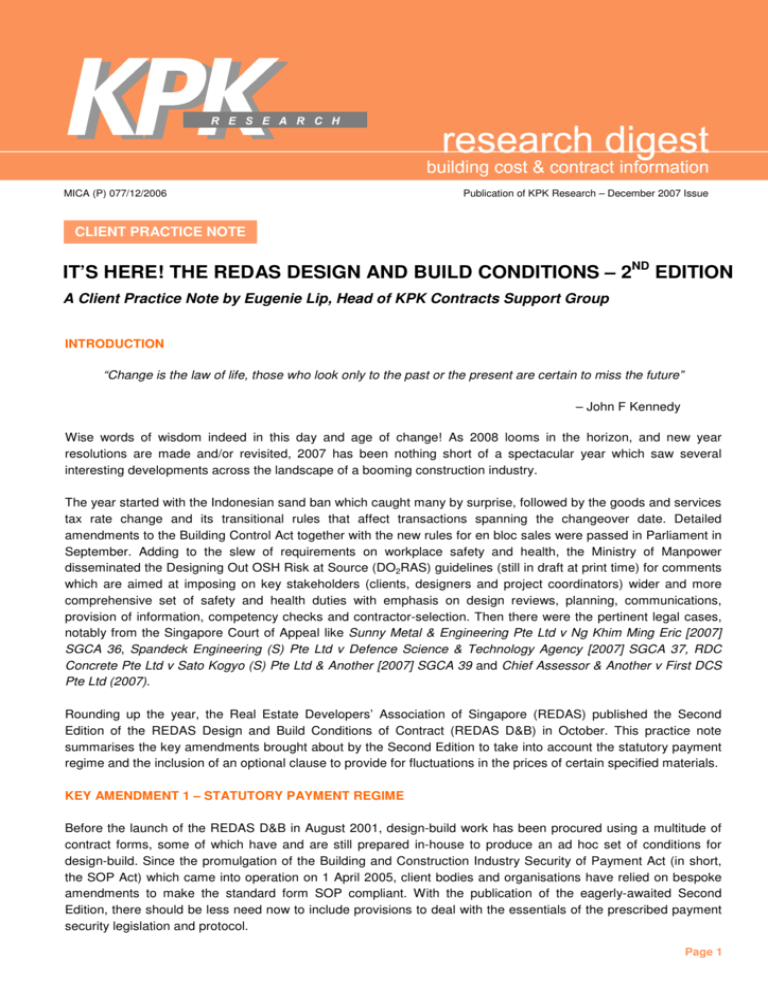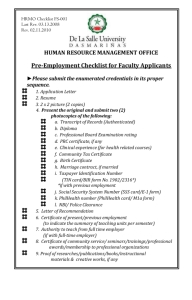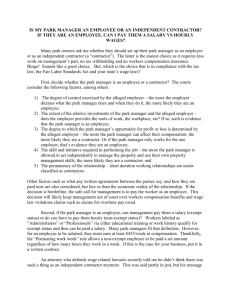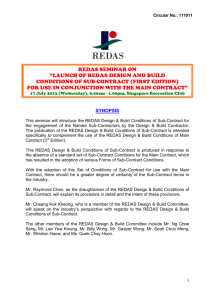
MICA (P) 077/12/2006
Publication of KPK Research – December 2007 Issue
CLIENT PRACTICE NOTE
IT’S HERE! THE REDAS DESIGN AND BUILD CONDITIONS – 2ND EDITION
A Client Practice Note by Eugenie Lip, Head of KPK Contracts Support Group
INTRODUCTION
“Change is the law of life, those who look only to the past or the present are certain to miss the future”
– John F Kennedy
Wise words of wisdom indeed in this day and age of change! As 2008 looms in the horizon, and new year
resolutions are made and/or revisited, 2007 has been nothing short of a spectacular year which saw several
interesting developments across the landscape of a booming construction industry.
The year started with the Indonesian sand ban which caught many by surprise, followed by the goods and services
tax rate change and its transitional rules that affect transactions spanning the changeover date. Detailed
amendments to the Building Control Act together with the new rules for en bloc sales were passed in Parliament in
September. Adding to the slew of requirements on workplace safety and health, the Ministry of Manpower
disseminated the Designing Out OSH Risk at Source (DO2RAS) guidelines (still in draft at print time) for comments
which are aimed at imposing on key stakeholders (clients, designers and project coordinators) wider and more
comprehensive set of safety and health duties with emphasis on design reviews, planning, communications,
provision of information, competency checks and contractor-selection. Then there were the pertinent legal cases,
notably from the Singapore Court of Appeal like Sunny Metal & Engineering Pte Ltd v Ng Khim Ming Eric [2007]
SGCA 36, Spandeck Engineering (S) Pte Ltd v Defence Science & Technology Agency [2007] SGCA 37, RDC
Concrete Pte Ltd v Sato Kogyo (S) Pte Ltd & Another [2007] SGCA 39 and Chief Assessor & Another v First DCS
Pte Ltd (2007).
Rounding up the year, the Real Estate Developers’ Association of Singapore (REDAS) published the Second
Edition of the REDAS Design and Build Conditions of Contract (REDAS D&B) in October. This practice note
summarises the key amendments brought about by the Second Edition to take into account the statutory payment
regime and the inclusion of an optional clause to provide for fluctuations in the prices of certain specified materials.
KEY AMENDMENT 1 – STATUTORY PAYMENT REGIME
Before the launch of the REDAS D&B in August 2001, design-build work has been procured using a multitude of
contract forms, some of which have and are still prepared in-house to produce an ad hoc set of conditions for
design-build. Since the promulgation of the Building and Construction Industry Security of Payment Act (in short,
the SOP Act) which came into operation on 1 April 2005, client bodies and organisations have relied on bespoke
amendments to make the standard form SOP compliant. With the publication of the eagerly-awaited Second
Edition, there should be less need now to include provisions to deal with the essentials of the prescribed payment
security legislation and protocol.
Page 1
IT’S HERE! THE REDAS DESIGN AND BUILD CONDITIONS – 2ND EDITION
A Client Practice Note by Eugenie Lip, Head of KPK Contracts Support Group
Making and Responding to Progress Payment Claims
Progress payment claims are served on the Employer (and copied to the Employer’s Representative) on the last
day of each month following the month in which the contract is made or as stipulated in Appendix 1 – Specific
Contract Information. Within 14 days of receipt of the Payment Claim, the Employer’s Representative must issue
an Interim Payment Certificate.
The REDAS D&B treats the Employer’s Representative’s Interim Payment Certificate as the Payment Response
by way of a ‘deeming’ provision. If
after 21 days from the service of the
21 days
Progress Payment
Payment Claim, the Employer does
14 days
7 days
not provide any Payment Response,
the
Employer’s
Representative’s
Payment Response
As in Appendix 1 (max
E Rep’s Interim
Interim Payment Certificate is deemed
35 days) from tax invoice
Takes precedence
Yes
Payment Certificate
If C not taxable person,
over Interim
as the Payment Response. Should
as in Appendix 1 (max 35
Payment Certificate
days) from payment
the Employer decide to give a
response due date
E
provides
Payment Response, he must act
C’s Payment
Tax
Payment
E pays
Claim
Invoice
Response?
within the 21-day period in which case
Design fees
the Payment Response provided will
Works properly executed
Variations, ditto
then take precedence over the
No
Materials at site
E Rep’s Interim Payment
Other items priced in contract
Employer’s Representative’s Interim
CertificateDEEMED as
Deduction for retention
Payment Response
Payment Certificate.
The procedure and payment timelines
for progress payments are illustrated
in Figure 1.
© Eugenie Lip
C: Contractor
E: Employer
E Rep: Employer’s Representative
Figure 1:
Progress Payment Timelines
Final Payment Claims
The Contractor has up to the expiry of the Maintenance Period to submit his final claim documents which must be
supported with full substantiation and showing all adjustments he considers should be made to the contract sum.
The final claim documents must be accompanied by a written discharge confirming that the total amount claimed
represents the full and final settlement of all monies due under the contract.
The Employer’s Representative has 3 months from receipt of the final claim documents and the written discharge
or the issue of the Maintenance Certificate, whichever is the later, to provide the Contractor with a Statement of
Final Account. Within 14 days from the issue of the Maintenance Certificate or the receipt of the Statement of Final
Account, whichever is the later, the Contractor serves a Final Payment Claim on the Employer (and copied to the
Employer’s Representative). The Final Payment Certificate is issued by the Employer’s Representative within 14
days of receipt of the Contractor’s Final Payment Claim.
The ‘deemed’ Payment Response provision for the Interim Payment Certificate equally applies in the case of the
Final Payment Certificate. Hence, if the Employer does not provide a Payment Response within the 21-day period
from the service of the Contractor’s Final Payment Claim, the Employer’s Representative’s Final Payment
Certificate shall be deemed as the Payment Response.
In the event where the Contractor fails to submit the final claim documents after the issue of the Maintenance
Certificate, the Employer’s Representative can make a written request to the Contractor to do so. If after 28 days
from the date of receipt of such written request, there is still no submission from the Contractor, the Employer’s
Representative may proceed to prepare the Statement of Final Account and issue the Final Payment Certificate.
Page 2
IT’S HERE! THE REDAS DESIGN AND BUILD CONDITIONS – 2ND EDITION
A Client Practice Note by Eugenie Lip, Head of KPK Contracts Support Group
The treatment of the Final Payment Claim in the REDAS D&B prevents an ‘ambush’ adjudication. This tactic
happens where a claimant having the advantage of preparing his case over a period of time, surprises the
respondent with massive and voluminous supporting files of documents, schedules, statements and the like. The
respondent is given a limited and tight time frame to prepare his response to what may be large amounts of
materials requiring detailed answers.
More importantly, the provisions also give regard to the decision of Tiong Seng Contractors (Pte) Ltd v Chuan Lim
Construction Pte Ltd [2007] SGHC 142. In this recent legal case, the judge ruled that final payment claims fall
within the ambit of adjudication under the SOP Act which should apply to both ‘final and non-final payments’.
When to Pay
The Employer must pay the
response amount stated in the
Payment Response within the time
frame stated in Appendix 1, or 35
days after the submission of a tax
invoice by the Contractor.
If the Contractor is a non-taxable
person under the Goods and
Services Tax Act, the time frame is
calculated from the payment
response due date.
Refer to Figure 2 which illustrates
the procedure and timelines
governing final payment claims.
21 days
14 days
14 days or MC,
whichever later
Final Payment
7 days
Yes
E Rep’s Final
Payment Certificate
E provides
Payment
Response?
C’s Final
Payment Claim
E Rep’s Statement
of Final Account
3 months
3 months or MC,
whichever later
BEFORE expiry of MP
No
Takes precedence
over Final Payment
Certificate
28 days
AFTER
issue of MC
E Rep’s
Written
Request
If C not taxable person,
as in Appendix 1 (max 35
days) from payment
response due date
E pays
E Rep’s Final Payment
Certificate DEEMED as
Payment Response
C: Contractor
C submits
Final Claim
Documents?
No
As in Appendix 1 (max
35 days) from tax invoice
Tax Invoice
Yes
C’s Final Claim
Documents + WD
Yes C submits
Final Claim
Documents?
No
Payment Response
E: Employer
E Rep: Employer’s
Representative
E Rep proceeds to:
Prepare Statement of
Final Account; and
Issues Final Payment
Certificate
MC: Maintenance Certificate
MP: Maintenance Period
WD: Written Discharge on total
amount as full and final
settlement of all claims due
© Eugenie Lip
Figure 2:
Final Payment Timelines
KEY AMENDMENT 2 – OPTIONAL CLAUSE FOR FLUCTUATIONS
Recognising that the risk ownership of fluctuations in prices of materials cannot be allocated solely to the
Contractor especially after Indonesia’s ban on sand exports and to allay concerns that such costs may be far too
much for some contracting firms to absorb on a fixed-price contract, the REDAS D&B has incorporated an optional
fluctuations clause which only applies if it is expressly incorporated in the contract.
Fluctuations are limited to prices of the materials to be specified by the Employer in Appendix 1. The Contractor is
paid or gives credit to the Employer for the difference between the current market prices of the specified materials
prevailing at the date of their delivery to the site and at the Base Date stipulated in Appendix 1. The current market
prices are based on the monthly published data of the ‘Recognised Relevant Authority’ named in Appendix 1 which
by default is the Building and Construction Authority (BCA) if no other organisation is stated.
Given that the published current market prices from the BCA are only in respect of ordinary Portland cement,
ready-mixed concrete grade 30 normal, 20mm high tensile steel bars, 20mm diameter granite aggregate and
concreting sand, the REDAS D&B has made it clear that the current market prices to be used in the calculation of
the difference shall be ‘regardless of the different types, grades or sizes’ of the specified materials to be
incorporated into the permanent works.
Page 3
IT’S HERE! THE REDAS DESIGN AND BUILD CONDITIONS – 2ND EDITION
A Client Practice Note by Eugenie Lip, Head of KPK Contracts Support Group
The Contractor is not entitled to any upward adjustment of the contract sum for fluctuations during the delay period
beyond the Date of Completion (or as extended).
The fluctuations clause applies to materials purchased by the sub-contractors of any tier under the Contractor
where the Employer has no involvement in the tender documentation and selection as such activities typically
come under the purview of the Contractor. In contrast, the applicability of the clause is excluded in named subcontracts unless expressly incorporated.
OTHER AMENDMENTS
The right to suspend work in consequence of non-payment of an adjudicated amount is reflected in a new
replacement clause and as a new ground for extension of time.
The Contractor may also terminate his employment if the Employer fails to pay the adjudicated amount within 7
days after the service of the adjudication determination or such other period as stated by the Adjudicator,
whichever is the later. This is activated by service of a notice to the Employer by the Contractor stating that if no
payment is made within 14 days after receipt of this notice, a Notice of Termination will be given which takes
immediate effect.
The other amendments made comprise legislative updates in the Employment of Foreign Manpower Act (Cap.
91A) and the reference to the revised Arbitration Rules of the Singapore International Arbitration Centre.
CONCLUSION
The release of the Second Edition is much welcome as it brings the REDAS D&B up to speed with what publishers
of other standard forms of main contract and sub-contracts have already done by way of amendments to
incorporate the statutory payment time frames and protocol, and align them with the consequences of nonpayment like extension of time for and rights to suspension of work, and removing any pay when paid provisions
which are unenforceable. The inclusion of an optional fluctuations clause will provide a more balanced risk
allocation against changes in prices of the specified materials identified in the contract.
REDAS D&B users should be aware of the Second Edition amendments to be made in their contract
documentation for new projects and to consider whether to incorporate the standard form for projects tendered but
pending an award.
The Second Edition will certainly go in some way to further increase the use of the REDAS D&B without having it
tweaked and tuned by legal advisers to address essential SOP Act matters. No doubt when the specimen contract
administration templates and named sub-contract conditions become available, the suite of REDAS D&B contract
forms will continue to grow in popularity to become the dominant form of contract in use for private sector design
and build projects.
For more information, please contact:
Ms Eugenie Lip
Head of KPK Contracts Support Group
DID: 6239 7323
Email: eugenielip@kpkqs.com.sg
Published by KPK Research. All rights reserved.
Disclaimer: The information presented in this publication is intended as a general guide only and is current at the time of publication. Whilst every
effort has been made to ensure accuracy, KPK shall not, in any way, accept liability for any loss resulting from its use.
KPK Research Pte Ltd undertakes research on a myriad of topics ranging from construction costs, procurement strategy to contract forms and conditions, hybrid
procurement approaches, professional practice and contract administration essentials. Some of the research findings are reflected and consolidated in various
publications, conference papers and published articles. All enquiries and feedback can be addressed to kpkresearch@kpkqs.com.sg
With offices in
Page 4
SINGAPORE CHINA INDIA INDONESIA VIETNAM THAILAND UNITED ARAB EMIRATES MALAYSIA (Kuala Lumpur Johor Bahru Pulau Pinang Sarawak Sabah)
KPK website: www.kpk.com.my KPK Research website: www.kpkresearch.com
Printed by Kairos Design
Page 4








